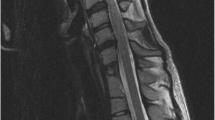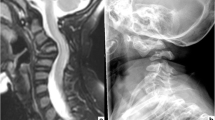Abstract
Klippel-Feil syndrome is characterized by a variable degree of congenital fusion of the cervical spine. It can exist in association with other mesodermal deformities affecting several systems. Symptomatic cervical disc prolapse in the context of the syndrome is well documented in young adults. We present a case of a 5-year-old girl with the syndrome, who presented with mild motor developmental delay and cervical cord compression from a prolapsed C3/4 intervertebral disc, seen on MR scan. She also had posterior elements fused from C-2 to C-4. She improved after cervical discectomy. The presence of degenerative disc disease at such a young age and at a level mechanically protected by posterior element fusion indicates a congenital primary defect, rather than mechanical stress fatigue.
Similar content being viewed by others
Author information
Authors and Affiliations
Additional information
Received: 3 February 2000 Revised: 21 July 2000
Rights and permissions
About this article
Cite this article
Allsopp, G., Griffiths, S. & Sgouros, S. Cervical disc prolapse in childhood associated with Klippel-Feil syndrome. Child's Nerv Syst 17, 69–70 (2001). https://doi.org/10.1007/s003810000377
Issue Date:
DOI: https://doi.org/10.1007/s003810000377




